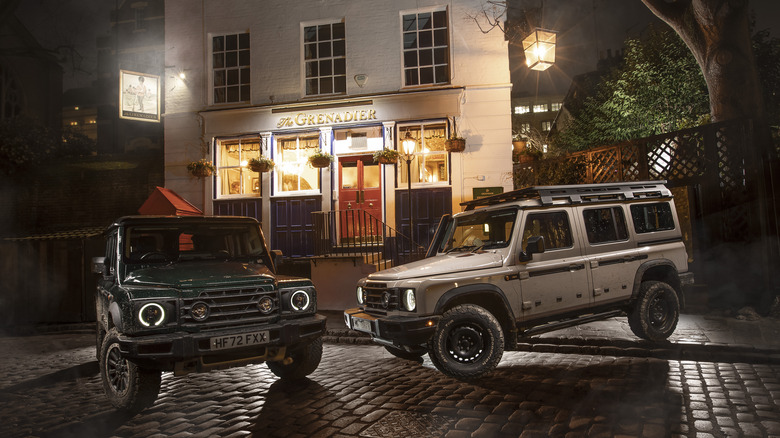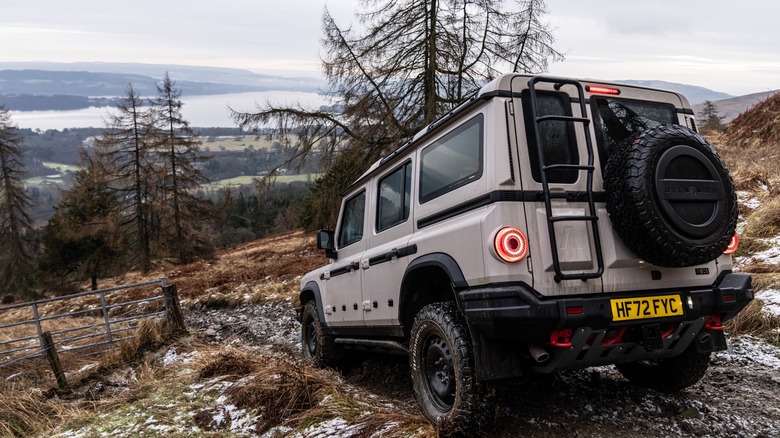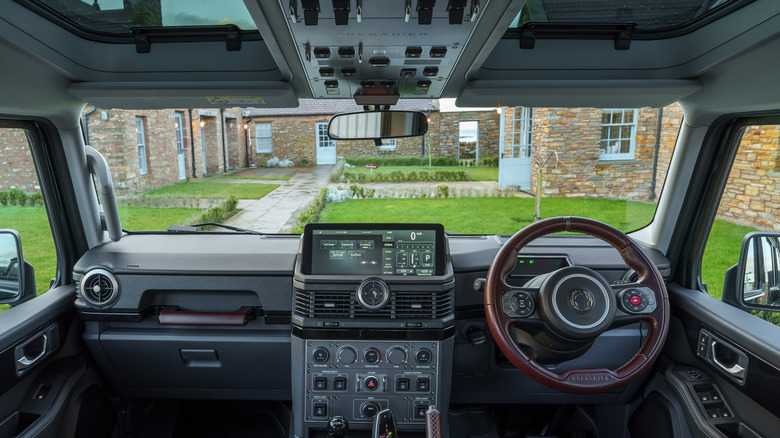New SUV On The Block: What To Know About The Ineos Grenadier
The first U.S.-market examples of an all-new SUV have just started to roll off a German production line. But it's unlike almost every other SUV currently on sale; there are no massage seats, no fridge for keeping something sparkling chilled for rear seat passengers, and no extended wheelbase to give them extra legroom, either. It's a car that claims to be hugely capable off-road but which asks as much from its driver as from its clever differentials.
In fact, it's probably unwise to even call it an SUV because the Ineos Grenadier is closer in ethos to a traditional off-roader. You know, those things we used to call 4x4s before the Range Rover went upmarket. A British vehicle that puts utility front and center, the Grenadier comes from Ineos Automotive, itself a division of Ineos, a global chemical company founded and owned by British billionaire and adventurer Sir Jim Ratcliffe. But what exactly is the Ineos Grenadier? Read on to find out.
Named after a London pub
The Grenadier gets its name from a central London pub frequented by Ratcliffe. It was at this pub, shortly after the retirement of the original Defender, that the Ineos boss spoke with friends about the idea of building his own car. A tiny establishment dating from the 1700s and with signed dollar bills covering the ceiling, The Grenadier is located on a cobbled road close to the Harrods department store.
Ineos Group purchased the pub in October 2022, shortly before it was used as the finish line for a media drive of the Grenadier that began in the Scottish Highlands and covered much of the UK before reaching London.
As well as Ineos Group and a very old pub, Lancashire-born Ratcliffe owns Swiss soccer club FC Lausanne-Sport, French soccer club Nice, and the first production Land Rover, which was built in 1948. Ratcliffe has previously attempted to buy the Chelsea and Manchester United football clubs, and Ineos currently sponsors the Mercedes-AMG Formula One team.
Inspired by the Land Rover Defender
In 2016, long before the first Grenadier rolled off the production line, Land Rover fan Ratcliffe tried to buy the tooling for the recently discontinued Defender, but Jaguar Land Rover refused. Not one to give up easily — the septuagenarian has trekked to the North and South Poles — Ratcliffe set about making a spiritual successor to the retired Defender.
Fast-forward to 2020, with the design of the Grenadier revealed, JLR mounted a legal bid to trademark the shape of the Land Rover. The carmaker lost this bid, leaving Ratcliffe free to continue his Grenadier project. The off-roader does indeed look strikingly similar to the previous-generation Land Rover Defender and isn't far away from an early Mercedes G-Class either.
Defender-esque details of the boxy Grenadier include flat front fenders onto which maps, tools, and cups of tea can be placed, while rear passengers are bathed in light from a set of mailbox-shaped windows along the roofline. There's also an exposed rear wheel on the split tailgate, smartly mounted backward so that the interior of the hub can be fitted with a door and used as storage.
Other Land Rover qualities include how the lower half of the interior can be hosed out and how the controls are designed to work while wearing gloves. So while there is a touchscreen, it can be controlled entirely with buttons and knobs if the driver wishes. The seats only have manual adjustments for a similar reason.
Powered by BMW
Under the Grenadier's hood, you'll find a 3.0-liter, turbocharged, inline-six engine sourced from BMW. It produces 282 horsepower and 332 pound-foot of torque, which is sent to all four wheels via an automatic eight-speed ZF transmission and a permanent all-wheel-drive system. A diesel 3.0-liter, also from BMW, is available as an option in the U.K. and Europe but won't be coming to the U.S. Ineos Automotive revealed a hydrogen-powered test car this year, and a smaller, all-electric Grenadier was announced by Ratcliffe earlier in 2023. The latter is expected to go on sale in 2026.
The Grenadier is not a quick car. Ineos claims a 0–60mph time only just below 10 seconds and a top speed of 99mph. But where Land Rover now sells a V8-powered Defender 110 that'll punch itself to 60 mph in a faintly absurd 4.9 seconds, the Grenadier is a car for slowly clawing its way over rocks and scrambling across muddy tracks.
That said, I drove the Grenadier earlier this year, and though it's undeniably a vehicle of utility instead of luxury, it rides pretty well, and both engines are surprisingly civilized when cruising at highway speed.
Overhead, airplane-style controls
Look up from the driver's seat in a Grenadier, and you'll be greeted by rows of roof-mounted buttons and toggle switches. These control the car's clever differentials and off-roading system — more on that in a minute — and include sets of pre-wired ancillary switches for powering roof lights, winches, and other off-roading accessories.
Metal hoops frame the most commonly-used controls, helping the driver locate them more quickly in a pinch, and at the front of the roof panel, there's a seatbelt warning light seemingly modeled on the no-smoking sign of an airplane cabin.
One of the Grenadier's few optional extras is a pair of "safari windows," which fit either side of the roof-mounted switches and can be opened or even removed, should you want to stand up for a better view of the local wildlife.
Speaking of options, the Grenadier is offered with two trim packs: Trialmaster and Fieldmaster. The former is the more off-road friendly of the two, while the latter is more luxurious, thanks to heated front seats and leather trim. U.S. Grenadier prices start at $71,500, and models equipped with either option pack run $79,190.
Three clever differentials for serious off-roading
Back to those differentials. On the Trailmaster edition, there's one on each axle, controlling power output to the left and right wheels, plus a central differential in the middle of the vehicle for managing how power is split between each axle. This system is designed to ensure the car will keep moving even when just one wheel has traction, and the front and rear differentials are manually locked/unlocked using those roof-mounted buttons. The differentials automatically disengage when driving at over 45 mph or when the car detects sufficient steering angle.
Such a system isn't breaking new ground, but the manual control system is interesting for a car made in 2023. Today's other SUVs (like the new Land Rover Defender) prefer to keep the driver out of the loop, instead using sensors and software to work out where traction is being lost and what type of ground it's being driven on, then adjusting the differentials accordingly. The Grenadier is a car for drivers who want to roll their sleeves up and get involved rather than sit back and let the computer work it all out for them.
Better as left-hand-drive
Although Ineos is a British company, the Grenadier actually suffers slightly when built as a right-hand-drive vehicle for its home market. This is because the routing of the exhaust system causes a major intrusion into the right-hand footwell, offsetting the pedals and leaving precious little space for the driver's left foot.
But because the exhaust is always on that side no matter which market the car is built for, left-hand-drive vehicles don't suffer from the same design flaw and instead have more space in the driver's footwell. That'll be good news to the more than 7,000 American customers who have already ordered a Grenadier. According to Ineos, that makes the U.S. the car's largest market worldwide.
The first American deliveries are scheduled to begin in November, with Canadian deliveries commencing in January 2024. The vehicles are built at a former Mercedes facility in Hambach, Germany, which used to produce Smart cars.






